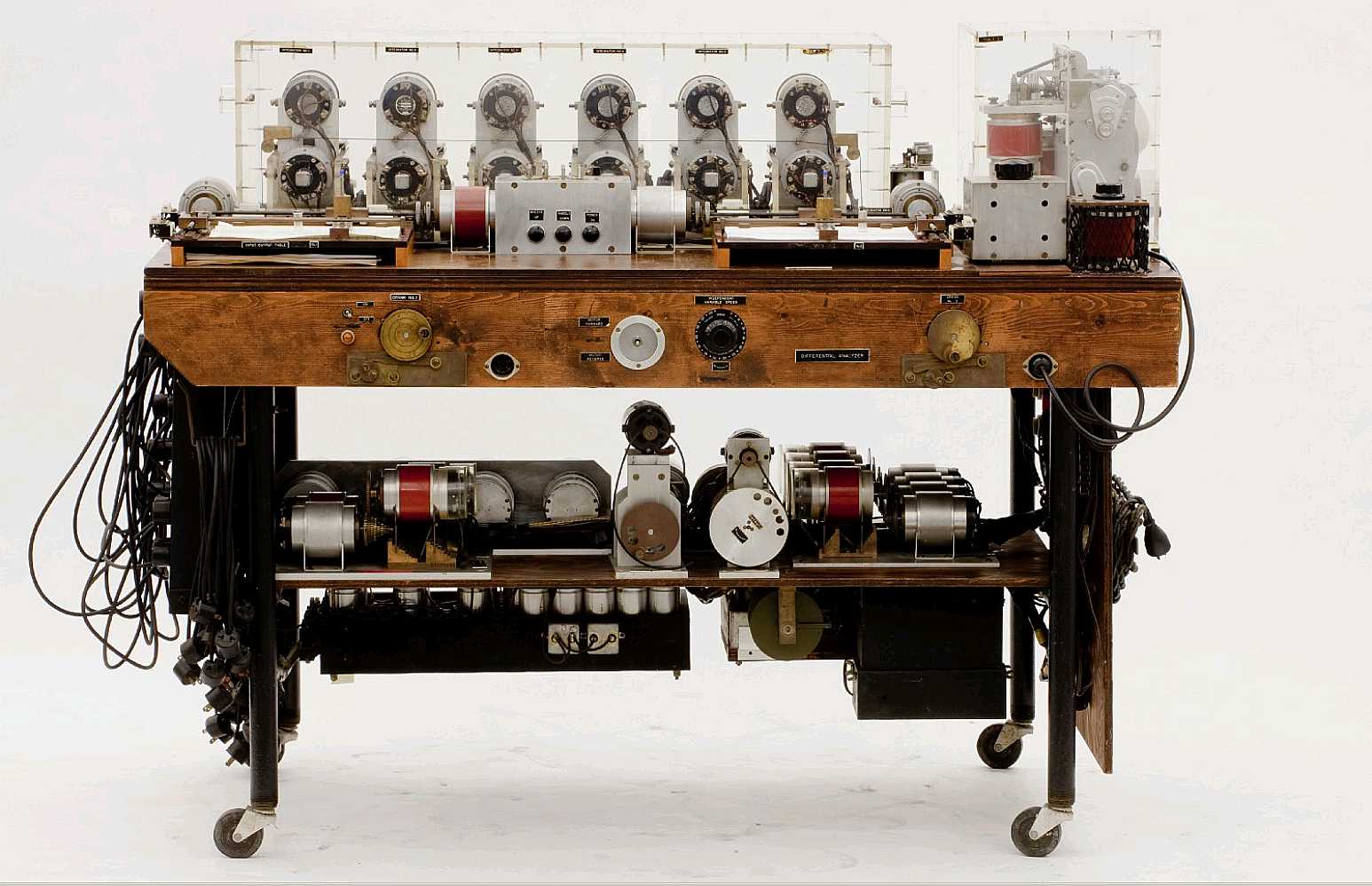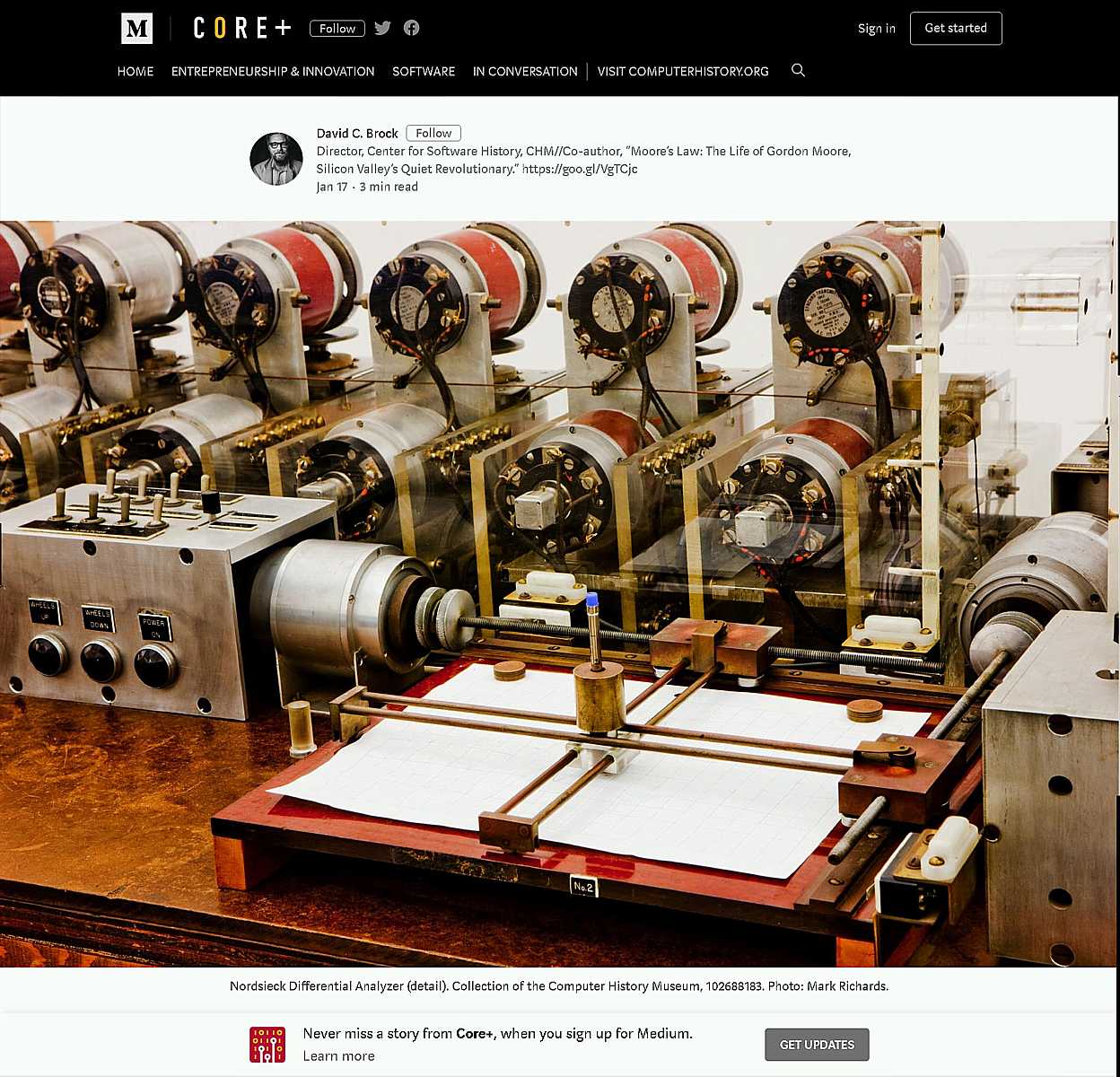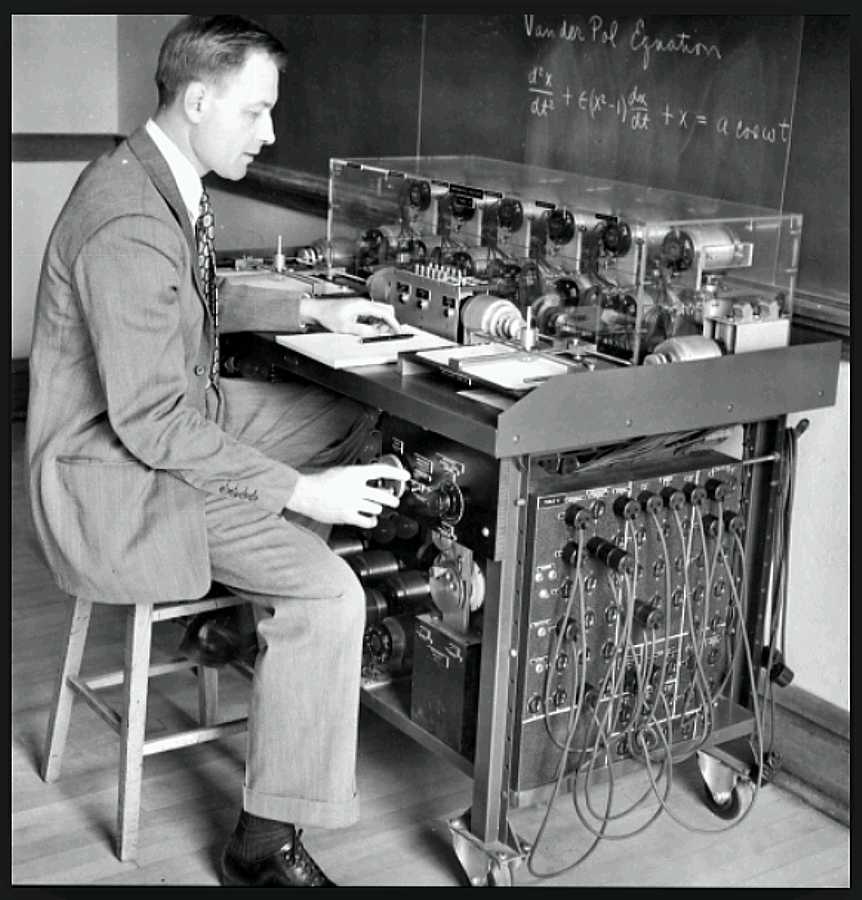Nordsieck Differential Analyzer
titled "The Shocking Truth Behind Arnold Nordsieck’s Differential Analyzer".
The following pictures are from the blog and https://www.computerhistory.org/revolution/analog-computers/3/138

front view
detail

The chalk board has the equation Van der Pol oscillator. This Differential Analyzer (and many other analog computers) has integrators, which can simulate dynamics such as movement, vibrations, and oscillations. Tim Robinson's Differential Analyzer. We think of computers as digital, doing the traditional add, subtract, multiply, divide, logic, conditional branchs ... From these we can compute logs, exponentials, trig functions... These are static, do not vary with time.
Digital computers can, with some care, do integrations which can simulate the real dynamic world. This is a discussion of Numerical integration, also Runge Kutta.
Tim Robinson commented
|
Hi David,
Bringing it back to life was fairly easy, just a few bad connections and some dead capacitors which had to be replaced. The remaining issue is on integrator 6, which uses a differential selsyn (as does integrator 5). These were modified by Nordseick from the originals (which were not capable of continuous rotation as manufactured). They had to fabricate a slip ring assembly and there is an open connection inside that on the unit on integrator 6. We decided not to attempt a repair at the time. I subsequently found some spares on ebay, but they would of course also have to be modified. I did track down a document which described the modifications and even gave the numbers of the original drawings for the parts. I sent that over to Dag to add to the archive. Everything was documented in detail when it was restored, and all the repairs are identifiable and reversible. I worked out setups with step by step instructions for a number of examples, using the 5 working integrators. I believe when everything was moved out of the old Visible Storage area in preparation for the Make Software exhibit, all the documentation was moved to the archives. There are also several boxes of spares which went into storage. Karen should know the details. The Revolution exhibit was set up to allow the unit to be powered and operated in place and early on I used to demonstrate it occassinoally. However, it has not been powered up in several years, so it would need a careful checkout before attempting to operate it again. It would also need cleaning and lubrication. The integrator disks build up a film of oil over time under the plexiglass cover and they will slip if not cleaned before use. Any stiffness will also cause slipping, so all the lead screws needed to be cleaned and lubricated periodically. There are some setups specifically designed to test for good operation. I did offer way back to provide a training class for docents if we wanted to offer regular demonstrations, but the staff never took me up on this, and most of the docents run a mile at the mention of anything analog, so it may have been difficult to get enough people to sign up. As with Babbage, running a regular demo program would require a significant commitment. Tim |
Text from the blog
|
Arnold Nordsieck started building his differential analyzer when most other computing researchers were experimenting with vacuum-tube digital electronic computers. Nordsieck needed a simple, cheap, and practical machine. A small differential analyzer fit the bill. Collection of the Computer History Museum, 102688183. Photo: Mark Richards. In 1950, the physicist Arnold Nordsieck built himself this analog computer. Nordsieck, then at the University of Illinois, had earned his PhD at the University of California, Berkeley, under Robert Oppenheimer. To make his analog computer for calculating differential equations, the inventive and budget-conscious Nordsieck relied on US $700 worth of military surplus parts, particularly synchros?—?specialized motors that translate the position of the shaft into an electrical signal, and vice versa. Nordsieck’s “Synchro Operated Differential Analyzer” was one of many electro-mechanical and electronic analog computers built in the 1950s. Compared with their digital counterparts, they were generally far faster at solving things like differential equations. In Nordsieck’s machine, the synchro units provided mathematical functions like integration and addition. The units were wired to a plugboard, where they could be interconnected in various ways using patch cords. As with other analog computers, each calculation required its own setup. You plugged in the tangle of patch cords to the left in a particular pattern. The cords served as the computer’s control program, with other parts of the program embodied and executed by the spinning disks, gears, rotating shafts, cranks, and the like. (You can read Nordsieck’s early description of the computer here local [PDF] and his written instructions here local [PDF].) The first step of setup was to remove all of the patch cords; you then plugged in the power cord and turned on the computer. Then, you replugged the patch cords in the proper pattern for the desired equation. Programming the differential analyzer could be painful. “The plugging operation is unfortunately accompanied by an electric shock hazard (though hardly a dangerous one),” Nordsieck warned, “since once one end of a cord is plugged in, the prongs of the free plug may have up to 105 volts of potential difference between them. Hence the operator should hold the live plug in such a way that the prongs do not touch him or anyone else or any metal.” Risk and reward were thus connected, even for a home-?brew analog computer. |
Started Jan 19, 2018